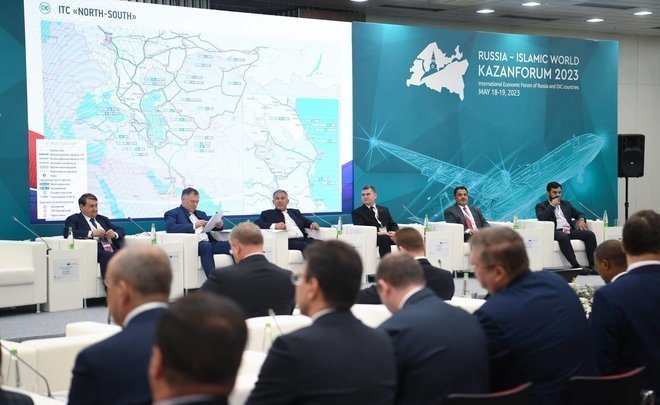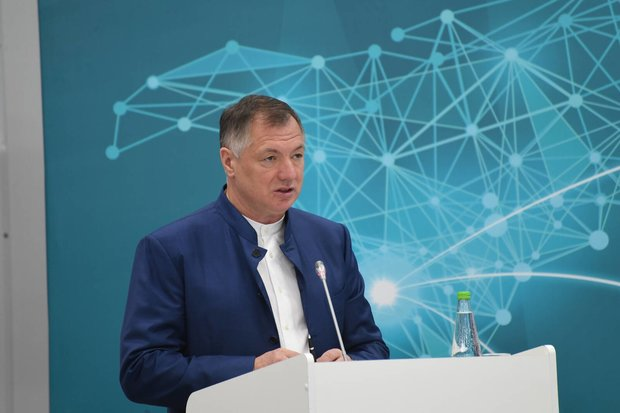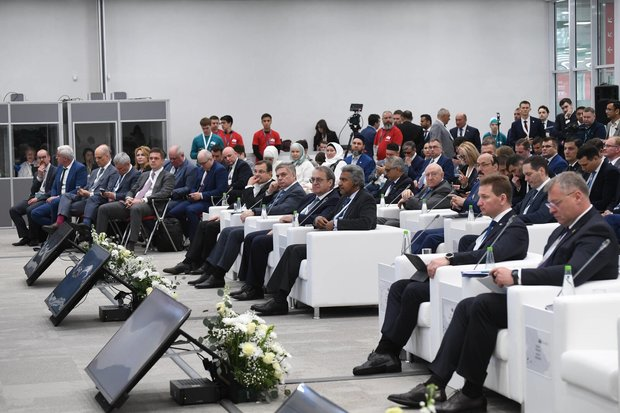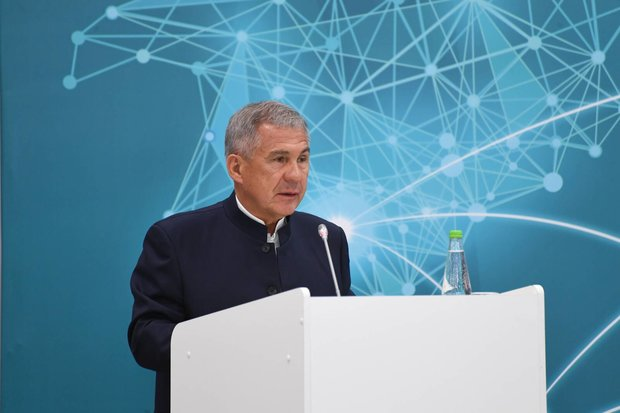‘Where to go now? To the East’: experts looked for ways for hundreds of millions of tonnes of freight bypassing the EU
KazanForum speakers about the International North–South Transport Corridor as the main road to connect Russia with the Muslim world

Russia is going to invest up to 280 billion rubles in the construction of the International North–South Transport Corridor, which is due to provide trade routes through the Persian Gulf to Near Eastern and Indian subcontinent countries. The country’s Vice Premier Marat Khusnullin collected new proposals to update the project at a morning round-table meeting at the Russia — Islamic World: KazanForum International Economic Forum. Authorities of Turkmenistan, the UAE, Oman who arrived in Kazan clearly pronounced for the extension of partnership, while the vice minister of agriculture of Iran warned about the necessity of construction of up to 800 new river-sea vessels to transport all the freight.
“We have to rebuild logistic chains”
The business agenda of the Russia — Islamic World: KazanForum International Economic Forum covers a wide range of economic cooperation with Muslim countries, but the reconstruction of transport and logistic routes amid European sanctions is the number one theme, of course. The International North–South Transport Corridor opening access to Persian Gulf ports for the expansion of trade with Near Eastern and Indian subcontinent countries is due to become an alternative to it.
A day earlier, Presidents of Russia and Iran Vladimir Putin and Ebrahim Raisi had signed an agreement to build a Resh — Astara railway section on the territory of Iran, while on 18 May morning Russian Vice Premier Marat Khusnullin decided to update the concept of the international transport corridor with representatives of Muslim countries — Iran, the UAE, Oman — whose territory the big route to the south will cross at the Kazan forum. As moderator of the session and ex-Vice President of Russian Railways and now President of the Russian Academy of Transport Alexander Misharin noted, at the moment the creation of alternative transport corridors around the world was topical, especially for Eastern European, Central Asian, Near Eastern and Southeast Asian countries. In this respect, the international transport corridor can become one of the main trade routes connecting Russia with the Muslim world.

Marat Khusnullin confirmed that the International North–South Transport Corridor was to become one of the key freight transportation channels to the south. According to him, freight turnover should double in this direction — from current 15 million tonnes to 30 million tonnes. The state intends to invest from 250 to 280 million rubles until 2030.
“The geopolitical situation has dramatically changed in the last years, we have to rebuild logistic chains and we are doing this actively. We think freight turnover in this direction should double by 2025, at least to 30 million tonnes. We constantly work to increase freight turnover between friendly countries,” the Russian vice premier indicated.
North-South will require over 40 river-sea vessels
Khusnullin noted that he gave priority to cars as the cheapest and most convenient in freight transportation. He says that this is how the western route of the corridor will develop (transportation through Dagestan, Azerbaijan and Iran). Another route — trans-Caspian — will go through ports of Astrakhan, Makhachkala to Turkmenistan. The eastern route is through Kazakhstan and Turkmenistan by car and railway. According to the speaker, money to bypass Russian cities will be allocated within a federal five-year road construction and repair programme. “Money was allocated for the Caucasus highway, ports of Astrakhan Oblast and Dagestan are developing,” he said. Alexander Misharin added that the North-South project would require over river-sea vessels. Commenting on the creation of the corridor amid a tense geopolitical situation, he noted: “If Allah closes one door, he opens a thousand of new ones.”

“The theme of transport corridors and logistic is always discussed, it is topical during trips abroad,” Rustam Minnikhanov continued the conversation. The rais of Tatarstan reminded the audience that the construction of the North-South corridor was raised at a meeting in Iran last year. “We saw how the Iranian side was interested in communication with Turkmenistan, Kazakhstan. These issues are crucial,” Minnikhanov stressed.
According to him, it was planned to sign agreement on free trade with Iran as early as since May 2018, but they had no sense without trade routes. Now the foundation is laid for trade and economic relations, which meets the interests of Eurasian states that are land-locked. Authorities of Turkmenistan, the UAE, Oman who arrived in Kazan clearly pronounced for the expansion of partnership, while the vice minister of agriculture of Iran warned about the necessity of construction of up to 800 new river-sea vessels to transport all the freight.
“We are late in this direction”
“The transport corridor has a special meaning for the Eurasian Economic Union as an important alternative corridor of economic development and as a reply to the economic and political influence of the European Union. The countries located along the North-South axis have been expressing their interest in the cooperation with the EAEU since May 2018 when there was signed an agreement on free trade with Iran. Analogous talks on free trade are held between the EAEU and India. South Asian and Persian Gulf countries are also interested. Also, there is huge potential of connecting the North-South corridor with latitudinal transport routes,” the Tatarstan rais noted.

Summing up the round-table talk, State Adviser to the Russian president Igor Levitin emphasised once again that it was vital to create new conditions for freight transportation.
“We signed the agreement on developing this project as early as 2005, but it didn’t develop then. Why? Because Russian companies focused on European ports up to 400 million tonnes of freight passed through,” Levitin explained the reasons why the North-South corridor didn’t develop. “We were late in this direction.”
However, there was another reason too. According to the state adviser, digital technologies that would provided multimodal transportation “in one bill” weren’t developed in the early 2000s, there was distrust.
“Where to go now?” Igor Levitin asked and replied himself: “To the East.”
He says the throughput of the North-South corridor is up to 50 million tonnes. 220 million tonnes of freight is left Russia has to look for new routes for.